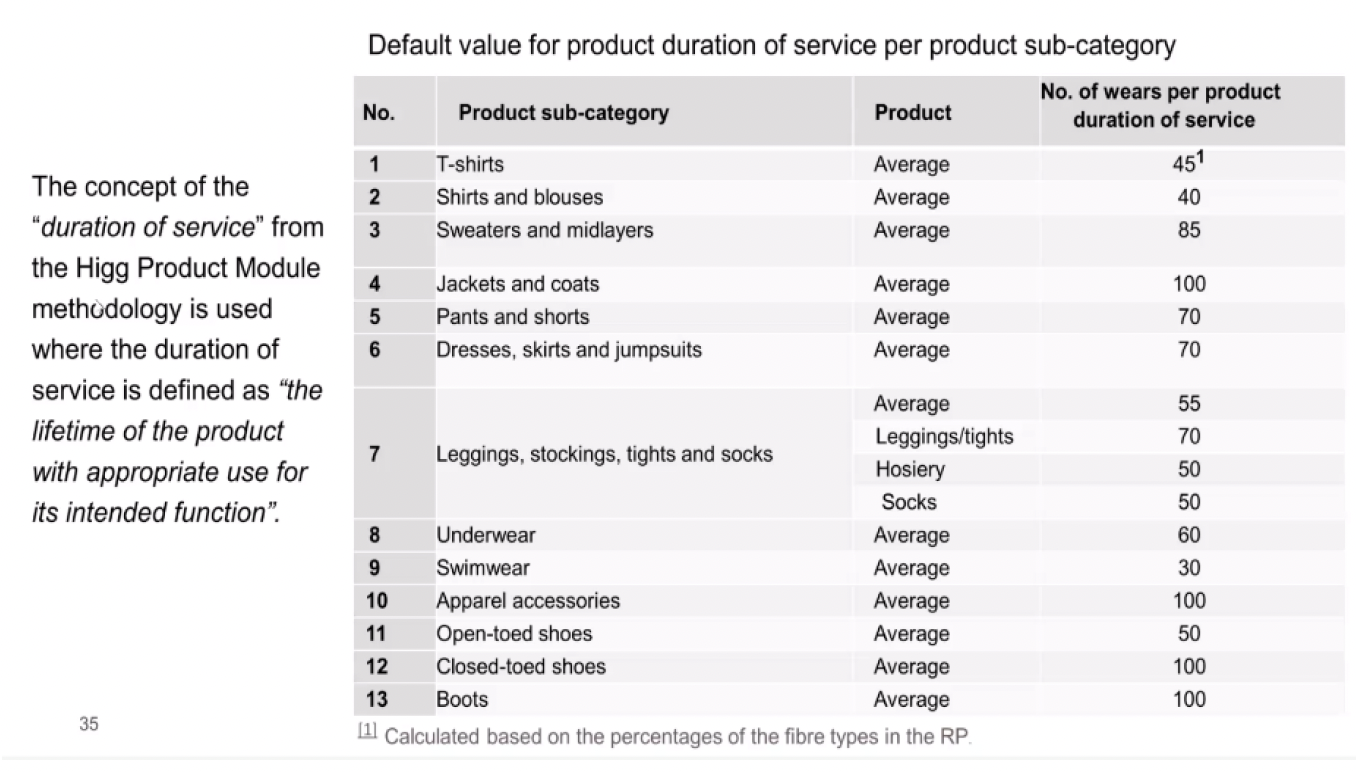The undersigned members of the Technical Secretariat of the PEFCR on Apparel & Footwear hereby voice their concerns to their peers and to the European Commission regarding the dysfunctions that the currently adopted procedure for the calculation of the “Duration of Service” of products provokes.
The “How long?” of the functional unit is meant to establish the length of time that apparel and footwear articles in the scope of the PEFCR remain in service. Time is a crucial factor for the calculation of the environmental footprint of products, as the longer a product remains in service, the lower will be its environmental impact.
However, at present the A&F PEFCR foresees that the duration of service of products is capped and will fail to reflect the reality of product lifetimes.
Table 7 sets the default duration of service values for the various product categories. Duration is expressed in the number of “wears” of a given article, independently over how long a period of time. Every wear is equivalent to 1 day of wear, independently of how long the article is worn. The source of the values is external to the Technical Secretariat. They stem from the Higg Product Module1 and are based on ‘expert’ judgement.
1 The Higg Product Module is a sustainability assessment tool that considers a product’s environmental impact from creating materials all the way to product end-of-life, developed by Cascale (formerly known as the Sustainable Apparel Coalition - SAC).
The values do not distinguish between constituting materials and have not been subject to review by the Technical Secretariat. They range from 40 wears/days for shirts and blouses to 100 wears/days for a pair of boots. That corresponds roughly to a “season”. According to the PEFCR v2.0 a durability multiplier should allow extending the default duration of service by a factor 0,67 to 1,45, and a repairability multiplier could bring that up to a maximum of 1,7.
The number of wears of an apparel and footwear product applies indistinctively to articles serving an occasion or a season and to those which will become a more permanent piece of the consumer’s wardrobe. The current method disregards that the lifetime of an article is also determined by its capability to withstand the passage of time, remain appealing and operational.
The lifetime extension multipliers are well intended, but they entail significant tests (hence, costs for operators) for a relative and in any case limited gain. Moreover, there are no test protocols for materials other than textiles in product categories, except for footwear.
All this leads to following dysfunctions:
- it incentivises short-living products (being actually used less than the default values) and penalises durable products (being actually used much longer than the default values).
- it impedes materials and products which are “made to last” to exploit their comparative advantage in the durability competition.
- it sets a de facto “ecodesign ranking” of materials which penalises in particular, natural materials and notably animal-based materials which, due to the limitations of LCA methodology2, have a higher cradle to gate footprint than synthetics.
2 Oil-based products benefit from system boundaries that do not include the environmental impacts of forming the raw material before extraction, while the formation of animal-based materials is fully accounted for. On the scale of the system boundary difference: “Using LCA and Circularity Indicators to Measure the Sustainability of Textiles—Examples of Renewable and Non-Renewable Fibres” - https://www.mdpi.com/2071-1050/14/24/16683
The proposed durability calculation method does not measure “time” (how long?) but “wears” (how often?) and by setting subjective default numbers of wears for each product category (not backed up by research), it does not take into account the actual duration that an article is worn, nor the duration it remains usable over time.
Expressing the longevity in “number of wears” is very difficult to visualise and understand for customers and consumers, as is the concept of “environmental impact per wear” that the single PEF score would convey. Consumers need to understand instead that every additional wear reduces the environmental impact of the article. The Default (and specific) Duration of Service should rather be expressed in years, applying the most common way to measure the lifespan of apparel and footwear. Measurement in ‘years’ would enable an ongoing feedback loop for improving assessment of Duration of Service, as this attribute can be measured once the Digital Product Passport and Waste Framework Directive are operational. Moreover, regarding the score display, the Specific Duration of Service should be explicitly displayed next to the PEF score to provide the customer with meaningful information.
The current method “equalises” all products in each product category, whether they are used once and thrown away, or hundreds of times and kept in service over a lifetime.
The undersigned organisations regret the proposed method’s failure to reflect ‘real-life’ Duration of Service and its failure to encourage supply chains to create longer-lived apparel and footwear products and value chains, which is what the UN SDG and the European Union (i.e. durability as a new ecodesign performance requirement) demand.
The apparel and footwear industries and their supply chains are in transition to a greener and more circular economy. The change of paradigm that the EU Green Deal policies have introduced forces all segments of the Textile-Clothing-Leather-Footwear ecosystem to adopt more sustainable business models. EU Regulations such as the Taxonomy, the ESPR, the Green Claims Directive, CSRD and CS3D are building the markets of the future. An immature methodology risks having highly damaging effects on the diversity and competitiveness of the industries in the ecosystem.
Materials, such as leather, suede, fur and other animal-based or natural materials whose nature and timeless beauty withstand much better the passage of time, need to be taken into account in the product segmentation for the calculation of the duration of service or in the reference flow.
Press release
CEC
Brussels 28 June 2024








